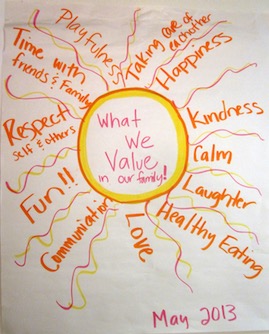Ask most parents what values they want their children to have and they can easily rattle off a list of wonderful traits such as empathy, respect, and self-discipline. Ask a child what is important to them, the answers may look more like stuffed animals, iPods and ice cream, but they have a pretty easy time answering as well But what does your family value? Is it the same as your own list? Is it the same as your child’s?
There's many exercise out there to help us, as parents, as parents, identify our own values. The next step is to bring our children into the conversation. When we get clear around our individual values, we know where we are headed as an individual. When we take this discussion to the family, we gain clarity on what is important to us as a family unit and create a shared vision of where we are headed together. In this post, we share how to create this vision with your own family.
But, first a word about “family values.” Funny how that phrase makes many of us cringe. Most would agree having values is important. Most believe adding value to our world is important. That phrase got a bad rap when some believed their individual values were for all families, not just their own family. Let’s start off by acknowledging that while families may share values, each family is unique and will value different traits and skills. It doesn’t matter if your family values the same things as the family next door, what matters is that your family is clear on what it values, and knows what those values look like in action.
The activity that follows should be split into two separate occasions. The first meeting should be creating a values list and the second is for diving deeper, and creating a shared definition of what those values mean.
Setting The Stage
Before we get to the heart of the activity, it’s important to think through the logistics so we can make this a fun, positive experience for our children. As adults, we know that when we are tired, stressed or in a hurry, it is not the best time for deep discussions. We know we won’t be as focused or engaged. We are not always as tuned in to when our children are in a similar place though, and pushing through just because the timing works for us is not going to create the experience we want. So, plan for a time that you are not in a rush and your children are fed and rested. In our family, this is usually a weekend morning. You know your family best, so be mindful of when the most opportune time for this may be.
Appropriate Expectations
As you can imagine, my family is often the guinea pig for trying out new activities. I quickly learned that having an expectation of how things “should” go can actually get in the way of the experience. I have had many wonderful surprises when I approach a new activity with an open mind, and let go of my image of success. If your family is new to this kind of discussion, let go of how this activity “should” go and see where it takes you. If you only get part way through, you can pick up where you left off another day.
Share The Power
This is not an activity where we tell kids what they value. This is not an activity where we tell them what they should or should not value. This is a team activity. Each member of the team must have an equal voice, and that voice should be heard and respected.
This is a great opportunity for parents to practice sharing appropriate use of power. You can do this by asking each family member to have a job in this exercise. Jobs might include someone to lead, someone to write (or draw pictures if they are not yet writing), and someone to keep track of time. If you need other jobs, you can get creative and have someone prepare a snack or whatever else you can think of. When we each have a job, we know that we matter and are more likely to contribute to the discussion.
EXERCISE #1: CREATE A FAMILY VALUES LIST
Invite your children to share what they love about your family. What do they enjoy most about family time? What do other family members do that they appreciate? What makes them feel safe and loved in their home? What would they like to see more of in family life?
Share your answers to these questions as well. Keep your ideas focused on what you want to see more of instead of less of. For example, if you want to see less fighting, share that you value calm, respectful problem solving. Focusing on the positive helps us know what we are moving towards instead of what we are moving away from and is more effective in creating change.
Write down a list of the values that are shared during this discussion. Let them know that on another occasion, you will talk more about what those values mean to each of you. We were so inspired by the list we created, that we have had it hanging on the wall ever since. It’s been a nice way to remind ourselves of what we hold dear.
Tips
- Remember, this is an exercise in sharing power. Your ability to let your kids do at least half, if not more of the talking is essential to your children feeling heard and willing to hear you.
- Avoid dismissing or correcting your child’s answers. Children will only trust this process if they feel their thoughts are important. When we dismiss or correct, we send the message that they are not skilled in doing this and risk losing their cooperation. If they express things they want less of, ask a question to help them find the value they would like to move towards instead.
EXERCISE #2: CREATE A SHARED DEFINITION OF VALUES
How many of us throw around words such as respect, kindness, and empathy without ever talking about what those words really mean? How do you define respect? How does your child? Are the answers the same?
Here are the more important questions: Does your child know what your definition of respect is? Do you know what your child’s definition of respect is? How can your child show respect the way you want them to if you have different ideas of what respect looks like? These same questions are often where we run in to challenges with our partners as well!
For example, I feel respected in my family when each person picks up after themselves. Tall order, I know! If you asked the rest of my family members if that is in their definition of respect, they would probably say no. If we don’t come to a shared definition, how will we know if we are showing our family those values?
Here’s the process for creating that shared definition of your family’s unique values:
1) Look at the list of values you created together as a family. Pick up to three values to define as a family. Write each one on the top of a page. Again, this is an important time for us to share power. If your children really want to select certain values, by all means, do! It’s more important to have them engaged in the process than for the values you want to be picked first. This exercise can be done over and over again, so there will be an opportunity for the ones that are important to you to be defined as well.
2) Make two columns under the value. On one side, write Looks Like and on the other write Sounds Like.
3) Brainstorm together what that value looks like in your family and what it sounds like in your family. Ask clarifying questions if you are unsure of what someone means. This is what your family values look like and sound like in daily life.
4) Post these up in the house so that you can all see them often. Share with your children these lists can be a reminder of what is important to your family along with how to use these values in daily life.
You can do this process for as many or as few values on your family list as you wish. You can revisit it when you notice the family drifting from these values. You can discuss, and clarify further. You can add to your main values list or the looks like and sounds like lists at any time as well. A yearly review can help your family continue to live your values in daily life.
We made our list of family values last spring and I had been thinking about how we could dig deeper ever since. This week’s family meeting was planned for New Year's Day, and my 8 year old suggested we do something special since it was a big day. So we picked a few values and went for it. At 5 and 8, my daughters were both able to identify what the values we chose looked like and sounded like, and seemed to really enjoy the activity.
The beauty is, when we do an activity like this together as a family, it feels good. When we feel good, we do good. We also help our children understand what these big words we throw around mean, and remind ourselves as well. Now you get to be on the look out for your family values in action!





